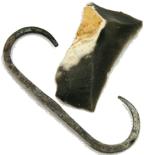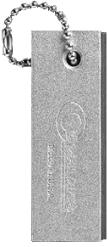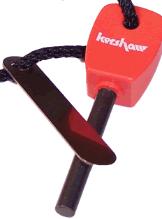
Fire from Sparks
Heat
. Without heat, you're doomed to having no fire. One way to get very hot, very intense, but very short-lived heat is by creating sparks. Sparks are usually tiny bits of super-heated metal that have been forcibly scraped from a larger chunk of metal.Flint and Steel
 Probably the most widely known primitive fire starting method, flint and steel has been used in guns, lighters, and fire making kits. When flint is struck against the steel, pieces of the metal are scraped off and blaze with white light and high temperature, but normally for less than a second. The quality of rock and metal being used make a big difference in the efficiency of the fire starter.
Probably the most widely known primitive fire starting method, flint and steel has been used in guns, lighters, and fire making kits. When flint is struck against the steel, pieces of the metal are scraped off and blaze with white light and high temperature, but normally for less than a second. The quality of rock and metal being used make a big difference in the efficiency of the fire starter.
The flint should be large enough to hold firmly and should have a sharp edge. A clear gray or black flint piece such as is used for gunflints is a good choice. The flint is really any hard mineral around 7 or 8 on the Mohs hardness scale that can keep a sharp edge similar to an arrowhead - agate, jade, bloodstone, chert, flint, jasper, quartz can all work.
The steel needs to be a piece of tempered high-carbon steel since it is the carbon which burns in the spark. Old metal files usually work well and can be found at garage sales cheaply. Steels are normally shaped into a 'C' or 'U' so they are easy to hold and manage. But, I just use a small, broken file from my Dad's old tool box.
You need one other special item for flint and steel fire starting - that is your char cloth. Char cloth is 100% cotton cloth such as old T-shirts or hand towels that has been turned into charcoal. Charcoal is fuel that has been heated to high temperatures without any oxygen. This converts flammable solids into gas, but does not allow it to burn. What is left is black cloth that very readily catchs and holds a spark and begins to burn as a red coal ember. It's easy to make your own char cloth.
Creating Char Cloth
Here are the simple steps to make your own supply of char cloth:
- Cut up an old T-shirt into about 2inch squares.
- Open a can of tuna fish (or cat food) and thoroughly clean, wash, and dry the can. You could use an old steel 35mm film canister or an Altoids tin.
- Poke a small 1/16 inch hole in the center of the lid.
- Start a small fire and let it turn to nice, hot coals. Or, use your gas barbeque grill.
- Fill the can with squares of cloth and firmly place the lid on. The lid needs to fit firmly. If the lid does not fit well, too much oxygen will get to the cloth and it will just burn up.
- Place the can in the hot fire and wait.
- Smoke should come out the hole in the lid as the cloth cooks.
- When the smoke stops, remove the can from the fire and let it cool.
- After the can is cool, open it. If you open it immediately, the cloth may flame up and it is ruined.
- The cloth should be black, but strong. If it is crumbly like ash, it was overcooked. If it is more brown than black, you need to cook it longer.
Using Flint and Steel
- BeginnersBefore making your fire, make sure you have plenty of fuel and kindling prepared and ready. Once you get flame from your spark, you only have a short time to turn that small flame into fire.
- Set up some very small kindling in a teepee shape with a space under it that an egg would fit in - this is where you will place your lit tinder.
- Prepare a silver dollar size pile of fine tinder and press a small hole in the top with your finger.
- Place a square of charcloth in the depression in the tinder and set it on the dry ground or piece of dry bark.
- Hold the steel in your left hand directly over and very close to the charcloth. The closer to the char, the hotter the sparks will be when they reach the char.
- Hold the flint in your right hand.
- Strike the flint down onto the face of the steel at about a 20-30 degree angle. The idea is to use the sharp edge of the flint to peel a tiny scrape of metal off the steel. Think of it as shaving a layer of metal off.
- Aim the sparks right into the charcloth and soon a spark will catch in the cloth.
- Set down your flint and steel and pick up the tinder ball with char cloth and ember.
- Gently and steadily blow onto the char ember to grow it, forcing the heat into the tinder. If you hold the tinder ball at about eye level or higher, the smoke will not get in your eyes so much.
- When a flame erupts, quickly place the tinder into your kindling and carefully feed the flame.
Using Flint and Steel
- AdvancedOnce you've mastered the Beginner version of creating a fire, this method is more efficient and easier.
- Set up some very small kindling in a teepee shape with a space under it that an egg would fit in.
- Prepare a silver dollar size pile of fine tinder and press a small hole in the top with your finger.
- Place this tinder in the palm of your right hand.
- Fold a piece of charcloth in half and then in half the other direction. This creates a piece that has one edge smooth and folded over and the opposite edge made of 4 separate exposed layers. The exposed layers are perfect for catching sparks!
- Hold your flint in your right hand.
- Place the folded charcloth on top of your flint and hold in place with the thumb of your right hand.
- Hold the steel in your left hand.
- Strike the face of the steel down onto the upturned edge of the flint at about a 20-30 degree angle. The sharp edge of the flint will scrape metal off which will embed in the charcloth sitting on top of the flint.
- Set down your steel.
- Using both hands, drop the char cloth into the depression in the tinder and set down the flint.
- Fold the tinder around the charcloth and blow on the ember, keeping your hands cupped around the tinder to hold in the heat.
- When a flame erupts, quickly place the tinder into your kindling and carefully feed the flame.
Magnesium and Ferrocerium Fire Starters
 The 'flint' in a cigarette lighter is a perfect example of this type of spark generator. There are many products available using the same concept and most do just what they advertise. The price range is very wide, but the Coghlan brand magnesium product is around $7.00 and does a good job.
The 'flint' in a cigarette lighter is a perfect example of this type of spark generator. There are many products available using the same concept and most do just what they advertise. The price range is very wide, but the Coghlan brand magnesium product is around $7.00 and does a good job.
This product includes the spark as well as its own tinder. Using a knife, you scrape shavings from the relatively soft magnesium block into a pile about the size of a nickel or quarter. Then, flip the block over to expose the edge that has an embedded sparking rod and scrape it with your knife. The resulting sparks catch in the magnesium shavings and burn a very intense, white-hot flame for a few seconds - long enough to start your additional tiny kindling burning.
If it is just a bit windy, the light magnesium shavings will be a challenge to keep in a small pile. Also, when striking down with your knife, it is easy to disturb the shavings. But, with this tool, you can get a spark and fire, even in the rain.
 There are a slew of different products ranging in size from tiny to mammoth and with different bells and whistles - all of which provide a shower of sparks from a ferrocerium rod. They are all providing pretty much the same service as the flint and steel. Use them to generate spark which you will catch in charcloth or other tinder.
There are a slew of different products ranging in size from tiny to mammoth and with different bells and whistles - all of which provide a shower of sparks from a ferrocerium rod. They are all providing pretty much the same service as the flint and steel. Use them to generate spark which you will catch in charcloth or other tinder.
This one pictured is pretty standard. It consists of a rod of material and a steel striker. This is about the size of a key and should last for hundreds of fires unless you lose it or break it.
Comments:
Oct 11, 2023 - Elsie Grobler
Ask a Question
Find more Campfire Resources at CampfireDude.com


Recent Comments